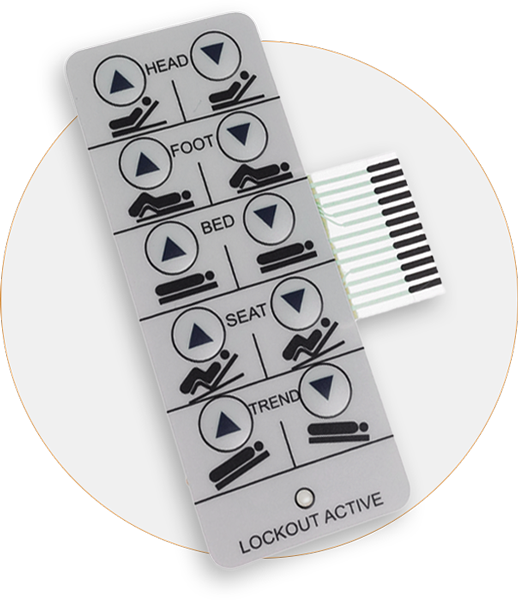Recognizing the Functionality of Membrane Layer Switches for Customer Interface Gadget
The functionality of membrane layer switches over stands for a significant improvement in individual interface style, incorporating performance with aesthetic versatility. These buttons operate through a multi-layered structure that equates customer interactions right into electric signals, enabling for both compact formats and durability versus environmental factors. As industries progressively focus on individual experience, understanding the subtleties of membrane layer switch modern technology ends up being essential. What ramifications do these innovations hold for future applications, and just how might they redefine customer communications across different tools?
What Are Membrane Layer Switches?
Membrane buttons are ingenious user interface gadgets that help with customer communication with electronic devices. These versatile elements include multiple layers, including a graphic overlay, spacer, and a printed circuit layer. The design permits a smooth assimilation right into different digital gadgets, enhancing both the visual and functional facets of individual interfaces.
Membrane layer buttons are commonly employed in a large range of applications, from family home appliances to industrial machinery and medical gadgets. Their construction normally features a slim profile, making them a suitable choice for compact styles. The responsive feedback provided by these switches can be engineered to satisfy details user preferences, guaranteeing efficient communication in between the individual and the device.
Durability is another significant benefit of membrane layer switches, as they are resistant to dirt, wetness, and chemicals, which enhances their life expectancy popular settings. In addition, these switches can be customized in terms of shape, size, and visuals design, enabling branding and user-specific attributes. Generally, membrane switches over stand for a practical solution for boosting individual experience in electronic gadgets, combining capability with aesthetic charm in a reliable manner.
Just How Membrane Layer Switches Job
Operating on a straightforward principle, membrane switches over make use of a layered building and construction to sign up customer input effectively. Each button includes numerous layers, consisting of a published circuit layer, a spacer layer, and a leading visuals layer, which are created to interact seamlessly. When a user presses the leading layer, it presses the spacer layer, bringing the conductive components of the circuit layer into contact with each various other.
This contact produces a closed circuit, signaling the gadget to carry out a specific function. The style enables different arrangements, including responsive comments, which can enhance the user experience by providing a physical experience upon activation. The materials made use of in membrane layer switches frequently consist of adaptable substratums, such as polyester or polycarbonate, which make certain longevity and durability against damage.

Secret Advantages of Membrane Layer Buttons

Another substantial advantage is their compactness. Membrane layer buttons are thin and lightweight, which makes it possible for producers to conserve area in their devices without sacrificing functionality. This attribute is specifically beneficial in applications where weight and volume are critical considerations.
Furthermore, membrane layer switches are resistant to dust, moisture, and chemicals, enhancing their toughness. This strength extends their life-span and reduces the demand for frequent substitutes, resulting in price financial savings in time.
In addition, the responsive comments provided by membrane buttons can be enhanced to boost user interaction. They can consist of functions such as increased switches or audible clicks, improving functionality and individual experience.
Applications Across Industries
User interface devices using membrane layer switches are widespread in a large variety of sectors, showcasing their adaptability and capability. Membrane Switch. In the medical field, membrane buttons are essential to tools such as browse around this web-site analysis devices and person tracking systems, where their toughness and simplicity of cleansing are critical for maintaining health standards. In a similar way, in the vehicle market, these buttons are utilized in dashboard controls and infomercial systems, giving a smooth and modern-day user interface for users.
Moreover, the customer electronics industry benefits from membrane buttons in home appliances and portable tools, where compact style and user-friendly user interfaces boost user experience. Industrial applications additionally take advantage of membrane layer changes for control board in equipment and read what he said automation systems, highlighting their effectiveness and resistance to extreme settings.
In the aerospace and protection sectors, membrane layer buttons are made use of in cabin controls and equipment, where reliability and efficiency under extreme problems are vital. In addition, the gaming sector significantly incorporates membrane switches in controllers and game machines, adding to an appealing individual experience. Generally, the flexibility of membrane layer switches over allows their extensive usage throughout many fields, highlighting their importance in contemporary interface style.
Future Fads in Membrane Layer Switch Modern Technology

In addition, the usage of innovative products, such as polycarbonate and polyester films, is anticipated to increase, giving enhanced durability and resistance to ecological stressors. These products add to the total longevity of membrane buttons, making them appropriate for harsher commercial applications.
Additionally, the incorporation of wise technology, including IoT connection, will make it possible for membrane layer switches to connect with other devices and systems, facilitating a more interactive individual experience. This pattern aligns with the growing demand for smart tools throughout various fields, from health care to consumer electronics.
Finally, personalization options are anticipated to expand, allowing producers to develop bespoke services customized to details individual requirements and preferences. These growths will certainly place membrane switches as essential parts in the evolution of user interface modern technology.
Final Thought
To conclude, membrane layer switches over represent a pivotal improvement in interface modern technology, supplying a dependable and functional option for varied digital applications. Their layered building promotes compact design, while attributes such as see page tactile feedback enhance individual communication. The resilience versus environmental variables further solidifies their utility across numerous markets. As advancements in material scientific research and touch noticing innovations continue, the functionality and applicability of membrane switches are expected to expand, reinforcing their importance in contemporary electronic devices.